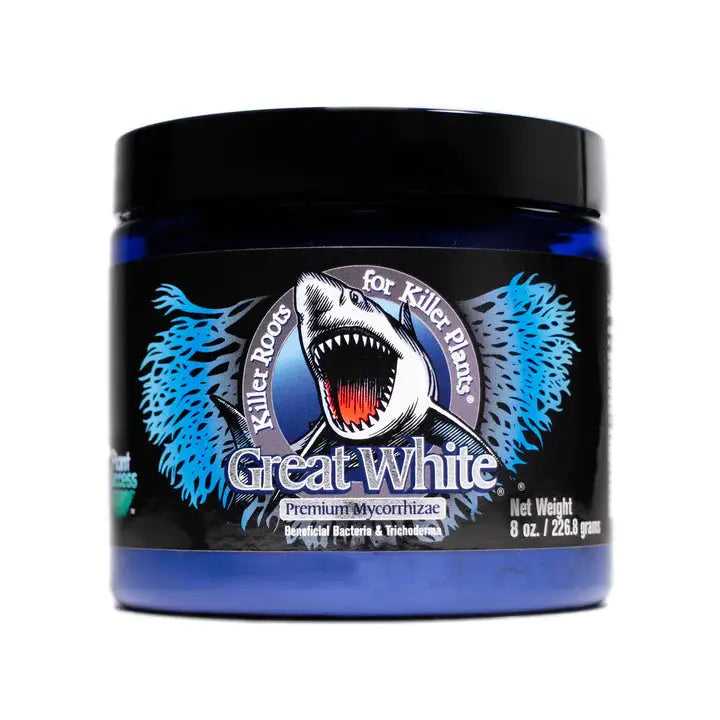
Great White Premium Mycorrhizae 226,8gr
Estimated Shipping Widget will be displayed here!
Characteristics of the root additive
Great White is the most advanced premium mycorrhiza formula on the market. This highly concentrated and diverse blend of beneficial microbes will help stimulate your plants' root systems, resulting in greater water retention and improved nutrient absorption.
Mycorrhizae form a type of symbiotic relationship between fungi and plant roots. The fungi colonize the roots and form a network of filaments called mycelium. In exchange for the sugars produced by the plant, mycorrhizae help increase root surface area, improve water and nutrient absorption, and protect roots from pathogens.
For gardeners, this symbiotic relationship can be beneficial in several ways. First, it can help improve plant health by providing additional nutrients and water. Second, it can help reduce the need fornutrient chemicals and pesticides. Finally, it can help improve soil structure and increase the population of beneficial microorganisms. Therefore, mycorrhizae play an important role in sustainable gardening practices.
Use
Great White can be used at all stages and for all types of cultivation. Use once a week for best results.
- Seeds: Sprinkle lightly with Great White.
- Cuttings: Dip the cutting in rooting gel/solution, then lightly dip it in Great White powder. Mix in pre-soak/fertilizer solution at the rate of 1 teaspoon or 3.3 grams per 2 gallons (7.5 liters) of water.
- Transplant: Lightly sprinkle the hole and place the plant directly on it.
- Potting Soil, Coco and Topdressing: Apply at the rate of 1 teaspoon (3.3 grams) per 2 gallons (9 liters) of water.
- Hydroponics: Mix in tank with regular feed at the rate of 1 teaspoon (3.3 grams) per 10 gallons (38 liters) of water.
Hydroponics users may notice a deposit or particles at the bottom of the tank, do not worry about product loss; it is normal for the carrier agent to settle.
Composition:
Endomycorhize
- Glomus aggregatum - 83 propagules par gramme
- Glomus intraradices - 83 propagules per gram
- Glomus mosseae - 83 propagules par gramme
- Glomus etunicatum - 83 shoots per gram
- Glomus clarum - 11 shoots per gram
- Glomus monosporum - 11 propagules per gram
- Paraglomus brazilianum - 11 propagules par gramme
- Glomus deserticola - 11 propagules par gramme
- Gigaspora margarita - 11 propagules par gramme
Ectomycorhize
- Pisolithus tinctorius - 187 875 shoots per gram
- Rhizopogon luteolus - 5 219 propagules par gramme
- Rhizopogon fulvigleba - 5 219 propagules par gramme
- Rhizopogon villosullus - 5 219 propagules par gramme
- Rhizopogon amylopogon - 5 219 propagules par gramme
- Scleroderma citrinum - 5 219 propagules par gramme
- Scleroderma cepa - 5 219 propagules par gramme
Bacteria
- Azotobacter chroococcum - 525,000 CFU (Colony Forming Unit) per gram
- Bacillus subtilis - 525 000 UFC par gramme
- Bacillus licheniformis - 525,000 CFU per gram
- Bacillus azotoformans - 525 000 UFC par gramme
- Bacillus megaterium - 525 000 UFC per gramme
- Bacillus coagulans - 525 000 UFC per gram
- Bacillus pumilus - 525 000 UFC par gramme
- Bacillus amyloliquefaciens - 525 000 UFC per gram
- Paenibacillus durum - 525 000 UFC per gram
- Paenibacillus polymyxa - 525 000 UFC per gram
- Pseudomonas aureofaciens - 525 000 UFC par gramme
- Pseudomonas fluorescens - 525 000 UFC par gramme
Contains the following 3 species:
- Trichoderma koningii - 187 875 UFC par gramme
- Trichoderma harzianum - 125 250 UFC par gramme
- Saccharomyces cerevisiae - 525 000 UFC par gramme
Choose options
